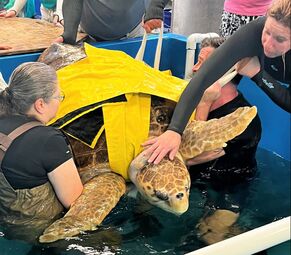 Snooki all wrapped up! Snooki all wrapped up! By Karen Sota We’re open for tours! After several months devoted to caring for cold-stuns plus the patients over wintering with us we’re happy to be able to welcome visitors again. During the month of March we’ll be open on Fridays and Saturdays from 11 AM – 2 PM. You will still need to purchase tour tickets in advance through our website www.seaturtlehospital.org. but you can visit the gift shop during those hours without taking the tour. We’ve spent the winter sourcing an incredible array of new items, along with the favorites in the latest colors. And of course, our adoption desk is always open when we are. With every March adoption you will receive a free copy of our inaugural hospital calendar featuring our very photogenic patients. The really exciting news for our visitors is that Snooki is once again in the big house, Sea Turtle Bay! After several months vacationing in the therapy pool in Sick Bay while we completed our Turtle Bay renovations and her tank was out for restoration she’s back. Since she’s been with us her time has been spent toward the back of the big house where it was almost impossible to see just how enormous and beautiful she is. Snooki now has a position of honor right up front next to the railing. Moving a turtle that weighs almost three-hundred fifty pounds was quite a process and took the entire team. Luckily, she likes and trusts “her people” and tried to cooperate as much as she could. She’s not real keen on being restrained in any way but after circling round and round to check out her bright yellow “Snooki Sling” she finally relented and let us guide her into position. Once snugly wrapped it took a village to lift her out of the therapy pool and settle her onto our turtle taxi for a ride. This zaftig lady never moved an inch as she rolled down the hall and into position in front of her tank, where she was hoisted to the edge on a board and unwrapped. It didn’t take her long to slip into her old home, enjoying the extra room and sparkling water. Just a word of warning to our visitors: Snooki likes to splash and fling water (lots of it!) with her ginormous flippers, usually to attract attention. Or maybe it’s just her way of showing love. You decide. Although cold-stun season is coming to an end please continue to keep an eye out for possible victims. If you see a turtle that has washed up on the beach or in our marshy areas or is in the water floating motionlessly don’t assume it is dead. They literally can’t move, maybe not even blink. Whether the turtle is big or small immediately call our Director of Beach Operations, Terry Meyer at: 910-470-2880. If she is not available, call the hospital during operating hours: 910-329- 0222. If the turtle is below the high tide line and in danger of washing out move it above the high tide line if you can do so safely. Ideally you should remain with the turtle until our trained volunteers arrive to retrieve it. If that is not possible find a way to indicate the location of the turtle on the beach by drawing large arrows in the sand or placing beach debris nearby. The State of NC hotline for stranded, sick and injured turtles is 252-241-7367. The state number picks up 24/7. All conservation work for endangered sea turtles at KBSTRRC and on Topsail Island is authorized by the NC Wildlife Resources Commission, ES Permit 23ST05.
0 Comments
We have once again welcomed 10 interns from UNC-Wilmington. They will spend their Saturdays learning about turtle care and husbandry as well as practicing their communication skills by teaching the public about sea turtles.
Let's meet our interns: Angelica: St. Peterburg, FL Marine Biology Major (Senior) I have spent 16 years in the military and decided it was time to go back to school and get a degree in something I am passionate about. The ocean and animals have always been that for me so a degree in Marine Biology was perfect. I became a volunteer at the KBSTRRC over a year ago and fell in love with caring for the Sea Turtles. I realized it's something I wanted to pursue in my future so doing an internship working hands on with the turtles just made sense. Bryce: I’m currently a senior at UNCW studying biology with minors in chemistry and environmental sciences. I’m from Poolesville Maryland and I’m grateful for this experience working with the KBSTRRC. Sea turtles are my favorite animal and since I was a little kid, I knew that I was going to be involved one day. This internship has allowed me to work hands on with the turtles along with an awesome team that I sincerely cherish. Ben: My hometown is Calabash, NC. and I am a junior at UNC Wilmington, majoring in Biology and minoring in Neuroscience. Every summer my family would visit Sunset Beach, NC, and that first sparked my interest in turtles as they nested on the island. I am very excited to be interning at KBSTRRC this spring and assisting in the sea turtle conservation effort! Lauren: I am from Ellicott City, Maryland! I am currently a junior at UNCW and I am a marine biology major. I'm so excited to be an intern here this semester and expand my knowledge of marine animal care. I hope my experience with this internship helps guide me in my decision of post-grad plans and my future career aspirations! Eric: Growing up in Richmond, Virginia, I was fortunate enough to have a family boat in the Chesapeake Bay where we spent as many weekends as possible cruising around and enjoying the water and all the wonderful forms of marine life found in the world’s largest estuary. It was during that time that I developed a deep affection for the ocean and aquatic life of all kinds, which ultimately led to me coming to UNC Wilmington to study marine biology. In my time here I was fortunate enough to watch a sea turtle nest hatch, as well as getting a tour of the turtle hospital. Something in me stirred after these events… I knew that I wanted to give back to the ocean in some way, and the Karen Beasley Sea Turtle Rescue and Rehabilitation Center seemed like the perfect way to give back to such beautiful animals in their times of need. Ian: I'm from Charlotte, NC and currently majoring in Biology at UNCW. I enjoy spending my time outside rock climbing, slack lining, or scuba diving. I grew up in a house filled with a variety of animals which sparked my scientific curiosity. After watching KBSTRRC releases I fell in love and decided to become an intern to be a part of their conservation efforts! Emma: I am from Cary, NC. I'm currently a junior at UNCW majoring in oceanography and minoring in marine biology and dance. I hope to work with sea turtles in my career and so this internship offers exciting, hands-on experience. I have absolutely loved the internship thus far and am excited for the rest of the semester! Hai: I am from Tay Ninh, Viet Nam. I'm currently a junior at UNCW for Marine Biology major and thinking of minor in digital photography. I plan to further study specifically about turtles and the deep sea after graduation since they are the reason why I am here in a different country, in this major and in this hospital. My dream job would be working on a crew that explore the Antarctic. I am happy to be here this semester. It is like a big check mark on my journey! Jenessa: I am from Hickory, North Carolina, and I’m currently a senior at UNCW. I am a marine biology major and a French minor. I would love to go to vet school in the future, but plan to work for at least a year before I apply to gain more diverse experience! I hope to continue working as a kennel tech and hopefully do more work as a vet assistant this coming year. I’m so grateful to be an intern with KBSTRRC this semester to add to my experience and work with wildlife! Raful: I am from Clayton, North Carolina, and I am currently a junior at UNCW. I am a marine biology major with a concentration in conservation. I plan on continuing to find and gain experience in this scientific field after I graduate, and hopefully work at a conservation and rehabilitation facility just like this one! I absolutely love sea turtles and am super grateful to be an intern here this semester to help spread awareness for these endangered and beautiful animals! 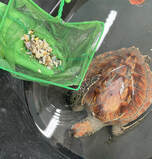 By Karen Sota There’s a famous Pete Seeger 1955 song titled “Where Have All the Flowers Gone?” that was covered by many folk groups in the 60’s. Today a re-write of that song might be “Where Does All the Plastic Go?” At our hospital we see first-hand where some of it ends up. Right before Thanksgiving we got a call that a turtle had stranded in North Topsail Beach. This little green was admitted with a body temperature of 63 degrees, so we suspected cold-stunning was the most likely the reason she ended up on the beach. She wasn’t loaded with barnacles or algae like most of the cold-stuns but she looked like she was wearing a necklace. It’s not the kind of accessory we like to see on any turtle because it usually means there was some interaction with fishing line or a net. We named this little cutie “Fuzzy Wuzzy” and she was given the standard course of meds, including treatment for anemia, and settled into a tank. Since she was in relatively good condition upon admittance we thought she might be a short timer. But she seemed to be having a buoyancy issue, especially in deeper water. Very often this is a temporary condition and will resolve as we keep the turtle in lower water levels so they remain horizontal, not listing or head or butt up. But Fuzzy Wuzzy had a surprise in store for us. Along with her normal digestive waste we were netting numerous pieces of plastic – for weeks! 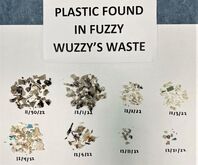 These were probably what most of us would consider “micro plastics” but if they were moving thorough your gut they probably wouldn’t feel so micro. All kinds of colors, sizes and shapes, and all with sharp edges. In the end this little six pound critter managed to pass a total of 14.5 grams of plastic, the equivalent of three typical credit cards. Ouch. The good news is that on January 3rd she caught a boat ride with a bunch of her friends to warmer waters, with a stern reminder from us to look for a different restaurant. Patients that have eaten plastic (and all kinds of trash) is not a one-off occurrence for us. It’s out there everywhere, and if the ocean is your home and that’s the only place you can get your food you’re in trouble. Years ago, comedian George Carlin, noting that plastic is not fully degradable, said that the planet would eventually shake us off like fleas and create a new paradigm “Earth Plus Plastic.” He was not trying to be funny. We’re hoping that the cold weather is coming to an end and we’ll probably be seeing fewer cold-stuns. We continue to rely on our locals and visitors to keep any eye out for victims of cold snaps. If you see a turtle that has washed up on the beach or in our marshy areas or is in the water floating motionlessly don’t assume it is dead. They literally can’t move, maybe not even blink. Whether the turtle is big or small immediately call our Director of Beach Operations, Terry Meyer at: 910-470-2880. If she is not available, call the hospital during operating hours: 910-329-0222. If the turtle is below the high tide line and in danger of washing out move it above the high tide line if you can do so safely. Ideally you should remain with the turtle until our trained volunteers arrive to retrieve it. If that is not possible find a way to indicate the location of the turtle on the beach by drawing large arrows in the sand or placing beach debris nearby. The State of NC hotline for stranded, sick and injured turtles is 252-241-7367. The state number picks up 24/7. All conservation work for endangered sea turtles at KBSTRRC and on Topsail Island is authorized by the NC Wildlife Resources Commission, ES Permit 23ST05. We’re getting ready to open on a limited tour schedule beginning in March. Tours will be on Friday and Saturday from 11AM – 2 PM. You will still need to purchase tickets in advance through our website www.seaturtlehospital.org. Our gift shop is loaded with tons of new turtle merchandise and you’ll be able to adopt one of our patients for those hard to buy for relatives and friends. Fan favorites Snooki and Lennie are looking forward to having visitors again after months seeing only our faces so be sure to check us out before the seasonal crowds. 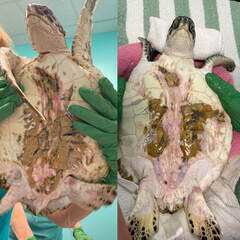 By Karen Sota We often use the term “sweet” when we talk about our patients. Although some of them may have a bad day every once in a while, there are many times when our turtles are literally sweet. We’re always searching for ways to improve our rehabilitation protocols, especially when it comes to wound care. Years ago we started using honey on wounds that were resistant to the normal topical creams and ointments. Although we were not sure it would actually help it did. In fact, it worked wonders. The turtles could get a little sticky but that’s small price to pay for the rapid improvements we see. So why honey? Maybe the story of recent admit “Pixie Dust” will answer that question. This little 3kg green came in from the Cape Lookout area on December 21 with a bunch of other cold-stuns. And if being almost frozen wasn’t bad enough she also had a large area of deep abrasions in the form of an arc on her plastron and other wounds typical of a shark bite. To add insult to injury, literally, she had sand in her eyes and was toting around a heavy load of barnacles. She was pitiful, and after a slow thaw was placed in the very critical section of Sick Bay. Her treatment protocol has been long and involved, initially including freshwater soaks to kill the barnacles. She’s been given fluids, vitamins and antibiotics along with betadine bandage soaks. Once stable enough we started honey treatments on that nasty shark bite. Obviously, you can’t just spread honey on a turtle and put it back in a tank of water. For Pixie it meant spending time on her back in a pillow of soft, fluffy towels. Honey was spread on her wounds, and she was off to dreamland (currently for ten minutes) while it worked its magic. With a bit of coaxing she finally started to eat, at which point we knew that the little girl had a future. If you want to see what honey can do for wound healing just look at the pictures of her on the day she came in and now. 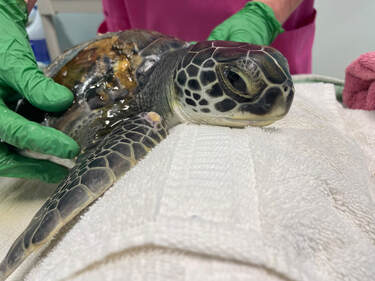 So, what makes honey so great, other than its taste? It has three main properties: it's antibacterial, anti-inflammatory and an antioxidant. It is acidic with a pH of between 3.2-4.5 and when applied to wounds encourages the hemoglobin to release oxygen which is critical to wound healing. It’s a sugar and sugar draws out the water in damaged tissues, reducing swelling. It also draws the water out of any bacterial cells and that keeps them from multiplying. And it’s completely safe for sea turtles. Pixie Dust will be with us for a while, and the staff love to spoil her. She has a perfect name for a perfect example of the magic we do at our hospital. We’re still admitting cold stuns like Pixie Dust. We really do rely on our locals and visitors to keep any eye out for victims of cold snaps. So, what do you do if you see a turtle that has washed up on the beach or in our marshy areas or is in the water floating motionlessly? First, don’t assume it is dead. They literally can’t move, maybe not even blink. Whether the turtle is big or small immediately call our Director of Beach Operations, Terry Meyer at: 910-470-2880. If she is not available, call the hospital during operating hours: 910-329-0222. If the turtle is below the high tide line and in danger of washing out move it above the high tide line if you can do so safely. Ideally you should remain with the turtle until our trained volunteers arrive to retrieve it. If that is not possible find a way to indicate the location of the turtle on the beach by drawing large arrows in the sand or placing beach debris nearby. The State of NC hotline for stranded, sick and injured turtles is 252-241-7367. The state number picks up 24/7. All conservation work for endangered sea turtles at KBSTRRC and on Topsail Island is authorized by the NC Wildlife Resources Commission, ES Permit 23ST05. We are officially closed to the public right now, but have tentative plans to re-open for limited days beginning in March. Check out the Visit page on our website for any updates Our gift shop is open year-round online so you can still find all kinds of cool turtle-themed merchandise, much of it exclusive to us. And if you’re looking for something for those impossible-to-buy-for relatives and friends, consider adopting one of our patients. 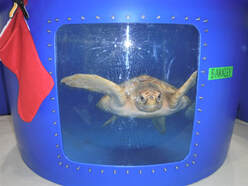 By Karen Sota We’re always ready to talk turtle. And during 2022 we had plenty to talk about. Last year we admitted the highest number of turtles in our history – 119. And that number doesn’t include the patients we had on site at the beginning of the year - making a total of 140 turtles cared for in 2022. To say we were exceptionally busy would be an understatement. And although turtles are our focus there’s a lot of public engagement and behind the scenes activity that must happen, too. Last year our staff devoted countless hours welcoming visitors for tours. We opened early in the year and were open more days than ever before. We now have an attractive portico to keep you all out of the sun and rain. We reworked our education hall exhibits with lots of cool visuals and a variety of videos. We added a “search for the turtles” scavenger hunt and coloring page for kids along with a box of special shells they could pick from upon completion. And the gift shop – just wow! We took it down to the walls and totally rebuilt it not only with display structures but with so much new turtle-themed merchandise it will make your head spin. We focused on keeping with our mission of conservation in selecting products, many of which are exclusive to us and support local artisans. But we didn’t stop with the hall. In October all on-site patients were temporarily relocated to other areas in the hospital while we undertook a much-needed rehab in Sea Turtle Bay. New energy-efficient lighting, rust repair and mitigation and the resurfacing of floors that were definitely showing signs of a decade of turtle care. The contracted work was completed on schedule and the critical time-consuming job of reconfiguring and replumbing tanks by our life support team began. Little by little the patients were moved back in, with a few of them getting tanks with a million-dollar view – a window. And we added information sheets about each of them along the railings so you can keep track of your photos during your tour. We have some exciting things planned for 2023, but with almost seventy patients currently in various stages of rehab we can’t really tell you when we’ll be able to open for tours again. The staff arrives in the dark and leaves in the dark. Most of these turtles are cold-stuns and some look like long-term cases. We’re hoping that we don’t get another week like the one that brought all these guys and gals in, but it is still technically winter. We rely on our locals and visitors to keep any eye our for victims of cold snaps. So, what do you do if you see a turtle that has washed up on the beach or in our marshy areas or is in the water floating motionlessly? First, don’t assume it is dead. They literally can’t move, maybe not even blink. Whether the turtle is big or small, immediately call our Director of Beach Operations, Terry Meyer at: 910-470-2880. If she is not available, call the hospital during operating hours: 910-329-0222. If the turtle is below the high tide line and in danger of washing out move it above the high tide line if you can do so safely. Ideally you should remain with the turtle until our trained volunteers arrive to retrieve it. If that is not possible find a way to indicate the location of the turtle on the beach by drawing large arrows in the sand or placing beach debris nearby. The State of NC hotline for stranded, sick and injured turtles is 252-241-7367. The state number picks up 24/7. All conservation work for endangered sea turtles at KBSTRRC and on Topsail Island is authorized by the NC Wildlife Resources Commission, ES Permit 23ST05. We are officially closed to the public for the year. Depending on our patient load we may be able to open for tours sporadically after the first of the year. Check out the Visit page on our website for any updates Our gift shop is open year-round online so you can still find all kinds of cool turtle-themed merchandise, much of it exclusive to us. And if you’re looking for something for those impossible-to-buy-for relatives and friends, consider adopting one of our patients. |
Archives
February 2024
Categories |
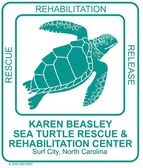
|
Quick Links |
Visiting Hours
THE TURTLES WELCOME YOU!
CLICK HERE FOR INFORMATION. ADMISSION (PLUS sales tax & fees): $7.00 General Admission (Ages 13-61) $6.00 Military (Active Duty and Veterans) $6.00 Seniors (Ages 62 and up) $5.00 Children (Ages 3-12) $0.00 Babies and Toddlers (Ages 0-2) (Babies are free but a ticket is still required to save their spot!) |
We are a 501(c)(3) Non-Profit Organization - POWERED BY VOLUNTEERS
EIN: 56-1967579
This conservation work for protected sea turtles at the Karen Beasley Sea Turtle Rescue and Rehabilitation Center and on Topsail Island is authorized by the North Carolina Wildlife Resources Commission, ES Permit 24ST05.
©
2024 Karen Beasley Sea Turtle Rescue & Rehabilitation Center
Powered by Volunteers!
Website Design by Loggerhead Designs
Powered by Volunteers!
Website Design by Loggerhead Designs

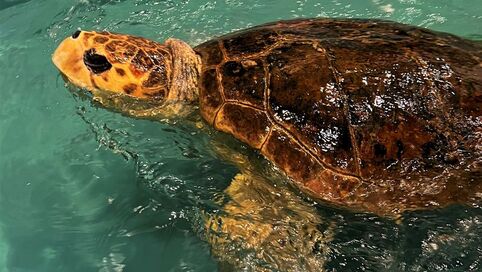
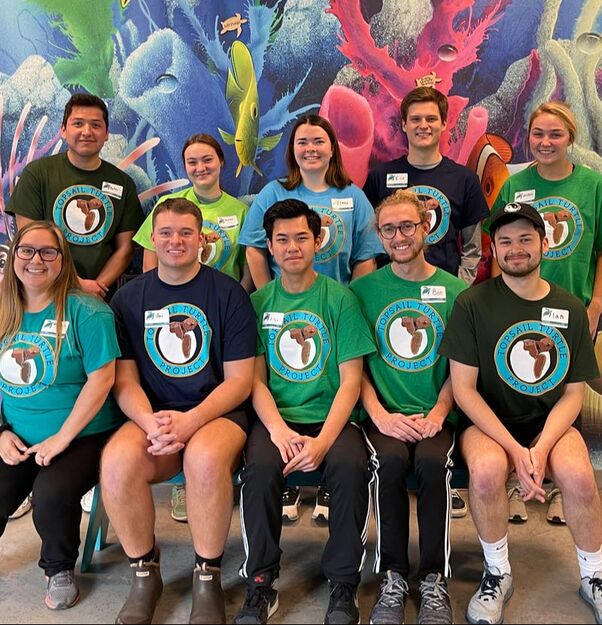
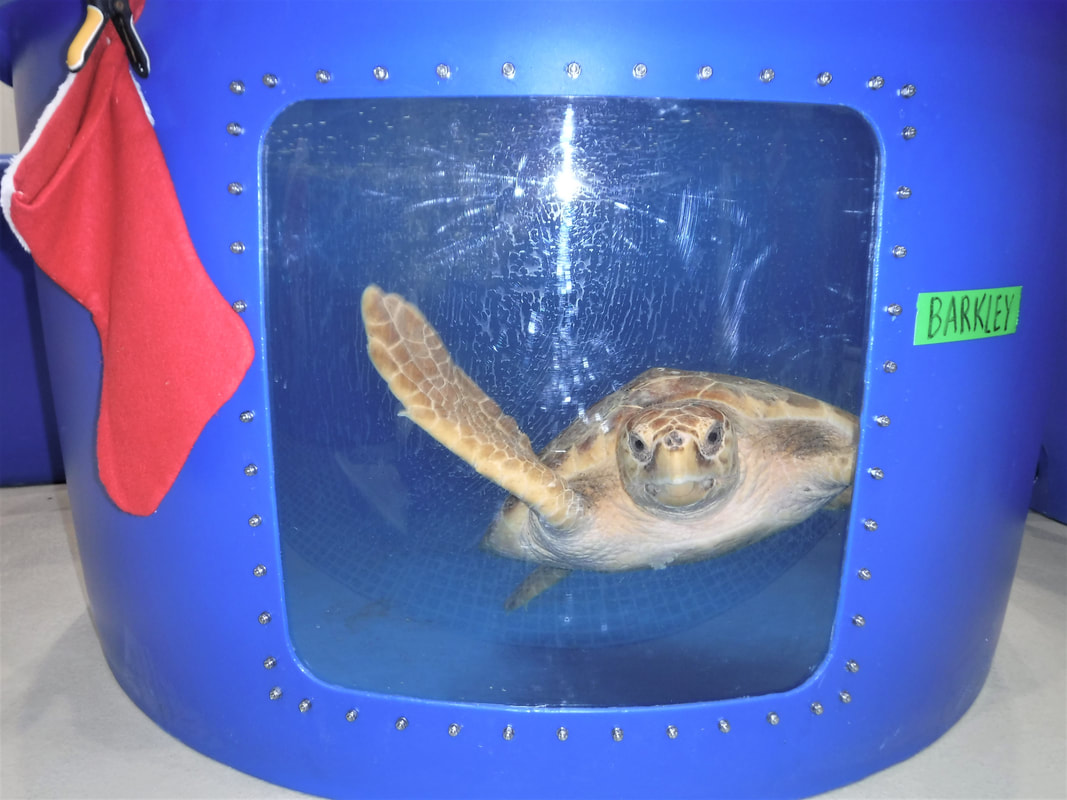
 RSS Feed
RSS Feed